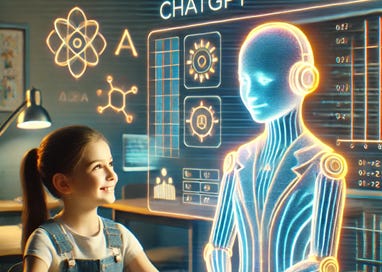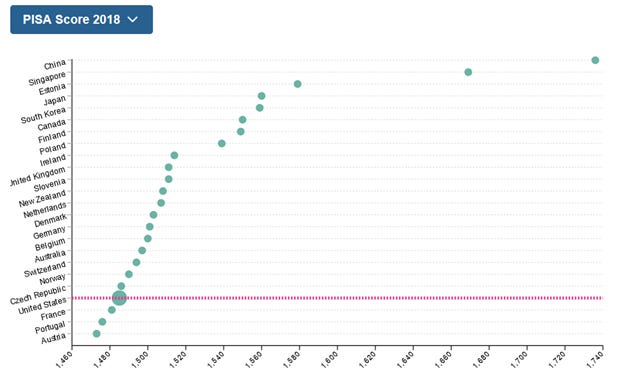Shortly after my book on The Deep Learning Revolution appeared in 2018, I gave a talk to a large general audience that kept asking questions long after the talk had ended. One question made me stop and think. I had given many examples of applications of deep learning networks – self-driving cars, diagnosis of medical disorders, advances in science – and the question was, which would have the most impact on our lives? After reflecting on this question, I realized that there was an application I hadn’t even mentioned that could have a massive impact on future generations: Education.
Students are already using ChatGPT to write essays for school assignments, which is difficult to detect and of great concern to teachers. A few teachers have decided that if you can’t beat them, join them, and have not only allowed students to use ChatGPT in their classrooms but have embraced it as part of their lesson plan. Here is an excerpt from one such teacher:
Jennifer Parnell [1], a history teacher at the Lawrenceville School, an independent school in Lawrenceville, N.J., was an early classroom adopter of ChatGPT. She began trying out AI chatbots in December and immediately incorporated the tools into her honors U.S. history and environmental science courses.
For a final exam in U.S. history, for instance, she used ChatGPT to manufacture an essay and then asked her students to analyze the A.I.-generated text for errors and rewrite it. Students also fed their own essays into the AI tool and asked it for feedback on the quality of their sources.
Parnell said she still has concerns about the use of AI tools in schools, including issues of bias, privacy and academic honesty. But she believed the potential benefits outweighed the downsides.
“A.I. has pushed teachers to think more intentionally about the purpose of education and specifically assessment,” she said. “As a teacher, if I’m asking questions that are easily answered by A.I., am I asking the best questions?” [2]
Teachers will not lose their jobs because of AI, but their jobs will change. As ChatGPT integrates into society, teaching students to use ChatGPT is also good job training. OpenAI has released a guide to help teachers use ChatGPT in their classrooms. [3]
Some reject ChatGPT outright – that’s not how we did this in the past – and others embrace and find creative uses. The rejecters rightly assert that if they allowed students to use ChatGPT, their ability to think independently and learn how to write would suffer. The embracers rightly realize that this new technology is the future and students should learn how to use it properly. We have gone through many technology shifts and found ways to live with them and thrive.
The introduction of hand-held calculators in the twentieth century was a technology shift that had a similar impact on education. Many teachers would not allow them in their classrooms. There was also a concern that students would lose the ability to perform mental arithmetic. However, with time, calculators found a niche that increased productivity, and it may be true that mental arithmetic has suffered, but it is still a mainstay of the three R’s.
The World of Education
Education is a trillion-dollar, labor-intensive business in the U.S. Brains are highly complex learning devices, and education is a cultural invention devised to train brains efficiently. The U.S. once had excellent universal education but has reached the bottom of the world ranking. According to the data in Figure 1, the U.S. is in the bottom quartile when compared to other Organization for Economic Co-operation and Development (OECD) countries according to the International Student Assessment (PISA), conducted by the OECD to evaluate education systems worldwide by testing the skills and knowledge of 15-year-old students.
Figure 1. Snapshot of reading, mathematics, and science performance of 15-year-old students in OECD countries. The countries are ranked in order by the PISA score on the x-axis. East Asian countries have pulled ahead of Western countries. China is far ahead. Estonia is the lone Western country in the top quartile, and the U.S. is near the bottom [4].
What went wrong? I live in California, where K-12 education was once among the best in the world. Still, even among states, it is now near the bottom. When I was learning how to read, I practiced until reading became automatic. I also learned how to write by practicing penmanship and arithmetic by practicing adding, subtracting, multiplying, dividing, and taking the square roots of numbers.
Practice has fallen out of favor in classrooms, and reform educators have shifted to a new approach that leads to better cognitive understanding but poorer skills. Practice in schools is considered “drill and kill,” which puts too much stress on children. Barbara Oakley and I have written a blog explaining why practice is essential for shaping efficient brain circuits [5] – what Daniel Kahneman called thinking fast.[6] Cognitive thinking is more flexible but slower and more prone to error. The brain has specialized systems for fast and slow thinking. Brains need a balance of these two learning systems, and so does ChatGPT.
ChatGPT Can Enhance Education
The most effective way to teach a child is one-on-one instruction from an experienced teacher who motivates the child to overcome learning problems with complex subjects like mathematics. In contrast, most schools have an assembly-line system designed for mass education: students are segregated by age, taught in large classes, and moved from class to class like an assembly line; teachers impart the same lessons year after year to children at the same physical age but not at the same mental age, making teaching much more difficult. An assembly line may be a good way to build automobiles, but it is a poor way to form children’s minds. The problems with our educational system have become more acute as they fail to educate students for many jobs now requiring a higher level of training and skills.
Computer programs that automate question-asking have been around for decades but are less effective than personal tutors. ChatGPT could have a significant impact, especially if they are equipped with long-term memory and can track the development of a student. A ChatGPT personal tutor, TutGPT, could provide children access to the world’s knowledge base. TutGPT teaching assistants would improve and transform current education practices in the U.S. Schools, which could still serve a useful purpose in tracking student performance, providing extracurricular activities and sports, and socializing students.
Prompting to Teach
How do good teachers interact with students to help them understand new concepts? A good teacher knows what the student doesn’t know, focuses on what needs to be known, and motivates the student to actively integrate the new knowledge into what the student already knows.
Ethan Mollick is on the Wharton School of the University of Pennsylvania faculty, where he teaches innovation and entrepreneurship and examines artificial intelligence’s effects on work and education. He engineered a prompt for tutoring ChatGPT into how to be an effective tutor:
“You are a friendly and helpful tutor. Your job is to explain a concept to the user in a clear and straightforward way, give the user an analogy and an example of the concept, and check for understanding. Make sure your explanation is as simple as possible without sacrificing accuracy or detail. Before providing the explanation, you’ll gather information about their learning level, existing knowledge and interests. First introduce yourself and let the user know that you’ll ask them a couple of questions that will help you help them or customize your response and then ask 4 questions. Do not number the questions for the user. Wait for the user to respond before moving to the next question. Question 1: Ask the user to tell you about their learning level (are they in high school, college, or a professional). Wait for the user to respond. Question 2: Ask the user what topic or concept they would like explained. Question 3. Ask the user why this topic has piqued their interest. Wait for the user to respond. Question 4. Ask the user what they already know about the topic. Wait for the user to respond. Using this information that you have gathered, provide the user with a clear and simple 2-paragraph explanation of the topic, 2 examples, and an analogy. Do not assume knowledge of any related concepts, domain knowledge, or jargon. Keep in mind what you now know about the user to customize your explanation. Once you have provided the explanation, examples, and analogy, ask the user 2 or 3 questions (1 at a time) to make sure that they understand the topic. The questions should start with the general topic. Think step by step and reflect on each response. Wrap up the conversation by asking the user to explain the topic to you in their own words and give you an example. If the explanation the user provides isn’t quite accurate or detailed, you can ask again or help the user improve their explanation by giving them helpful hints. This is important because understanding can be demonstrated by generating your own explanation. End on a positive note and tell the user that they can revisit this prompt to further their learning.” [7]
Try out this prompt and pretend you are a student having difficulty learning something you already know.
The Future of Education
Deep Blue was a chess-playing program designed with special-purpose chips by IBM that could explore game positions farther than humans could. Deep Blue beat the world chess champion, Gary Kasparov, in 1997. Chess-playing computer programs powered by AI have learned to play far better than Deep Blue. Has this stopped humans from playing chess? On the contrary, it raised our level of play. It has also democratized chess. The best chess players once came from big cities like Moscow and New York, which had a concentration of grandmasters who could teach younger players and raise their level of play. Chess-playing computer programs made it possible for Magnus Carlson, who grew up in a small town in Norway, to become a chess grandmaster at thirteen, and he later became the world chess champion. ChatGPT tutors could similarly raise everyone’s educational level on the planet. AI can make us all smarter.
[1] https://www.linkedin.com/in/jennifer-parnell-m-ed-m-a-99a08a5b
[2] Natasha Singer, How teachers and students feel about A.I. https://www.nytimes.com/2023/08/24/technology/how-teachers-and-students-feel-about-ai.html
[3] Teaching with AI. https://openai.com/blog/teaching-with-ai
[4] https://worldpopulationreview.com/country-rankings/pisa-scores-by-country
[5] B. Oakley and T. Sejnowski, "The Promise of Habit-Based Learning," Law & Liberty, 2022. https://lawliberty.org/features/the-promise-of-habit-based-learning/
[6] Kahneman, D., Thinking, Fast and Slow. (New York, Farrar, Straus and Giroux, 2011).
[7] Ethan Mollick, “Now is the time for grimoires,” https://www.oneusefulthing.org/p/now-is-the-time-for-grimoires [A grimoire is a a textbook of magic, typically including instructions on how to create magical objects like talismans and amulets, how to perform magical spells, charms, and divination.]






Thank you Professor for yet another insightful article.
I am super excited about the potential positive impact of AI on education.